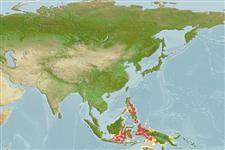Common names from other countries
Environment: milieu / climate zone / depth range / distribution range
Sinh thái học
Biển Cùng sống ở rạn san hô; không di cư; Mức độ sâu 5 - 33 m (Ref. 5222). Tropical; 20°N - 12°S, 111°E - 149°E (Ref. 5222)
Western Pacific: Philippines, Indonesia (Sulawesi, Flores), and Papua New Guinea.
Bộ gần gũi / Khối lượng (Trọng lượng) / Age
Maturity: Lm ? range ? - ? cm
Max length : 25.0 cm TL con đực/không giới tính; (Ref. ); common length : 20.0 cm TL con đực/không giới tính; (Ref. )
Các tia vây lưng cứng (tổng cộng) : 9; Các vây lưng mềm (tổng cộng) : 14; Tia cứng vây hậu môn: 3; Tia mềm vây hậu môn: 8. Similar to the more common Cephalopholis spiloparaea but lacks banding in the caudal fin (Ref. 48635); characterized further by reddish brown color; base of pelvic fins with indistinct dark blotch; greatest body depth 2.5-2.9 in SL; rounded caudal fin; short pelvic fins, 2.3-2.5 in head length; strongly bilobed margin of front of upper lip (Ref. 90102); head length 2.1-2.3 times in SL; rounded preopercle, posterior edge finely serrate, lower edge fleshy; very convex upper edge of operculum; maxilla extends past eye; teeth large; midlateral-body scales ctenoid (Ref. 89707).
Inhabits protected or silty reef areas (Ref. 89707). Reported to be very habitat speciific, lives in very rich invertebrate habitat in the shore side of inner reefs and difficult to get shots u/w. Largest seen was about 25 cm, but usually smaller up to about 20 cm (R. Kuiter, pers. Comm. 03/2022). Maximum length given 40 cm TL (for confirmation) May undergo protogyny. Solitary (Ref 90102).
Life cycle and mating behavior
Maturities | Sự tái sinh sản | Spawnings | Egg(s) | Fecundities | Ấu trùng
Heemstra, P.C. and J.E. Randall, 1993. FAO Species Catalogue. Vol. 16. Groupers of the world (family Serranidae, subfamily Epinephelinae). An annotated and illustrated catalogue of the grouper, rockcod, hind, coral grouper and lyretail species known to date. Rome: FAO. FAO Fish. Synop. 125(16):382 p. (Ref. 5222)
IUCN Red List Status (Ref. 130435)
CITES (Ref. 128078)
Not Evaluated
Threat to humans
Harmless
Human uses
Các nghề cá: không ích lợi (thú vị)
Các công cụ
Special reports
Download XML
Các nguồn internet
Estimates based on models
Preferred temperature (Ref.
115969): 28 - 29.1, mean 28.5 (based on 68 cells).
Phylogenetic diversity index (Ref.
82804): PD
50 = 0.5000 [Uniqueness, from 0.5 = low to 2.0 = high].
Bayesian length-weight: a=0.01259 (0.00590 - 0.02687), b=3.04 (2.87 - 3.21), in cm Total Length, based on LWR estimates for this Genus-body shape (Ref.
93245).
Mức dinh dưỡng (Ref.
69278): 4.0 ±0.7 se; based on size and trophs of closest relatives
Thích nghi nhanh (Ref.
120179): Trung bình, thời gian nhân đôi của chủng quần tối thiểu là 1.4 - 4.4 năm (Preliminary K or Fecundity.).
Fishing Vulnerability (Ref.
59153): Low vulnerability (15 of 100).
